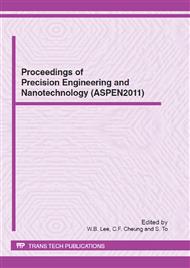p.343
p.349
p.355
p.361
p.367
p.373
p.378
p.384
p.390
Investigation for High Speed Ultrasonic Cutting of Aluminum Alloy
Abstract:
This study investigated phenomena of ultrasonic cutting in the case of high-speed conditions. Ultrasonically assisted cutting techniques were developed by Kumabe in the 1950s. He found a critical cutting speed that limits cutting speed to obtain ultrasonically assisted effects and is calculated by frequency and amplitude of oscillation. In general, ultrasonically assisted cutting is not suitable for high-speed cutting conditions because the effects of ultrasonic application are cancelled due to tool contacts with the workpiece during the cutting operation. Present ultrasonically assisted cutting cannot allow increased cutting speed because cutting speed is limited by a critical cutting speed that is less than that compared with general cutting speed. And ultrasonically assisted cutting cannot improve productivity due to long processing time. We conducted high-speed ultrasonic cutting, and the maximum cutting speed in this research was 300 m/min which is higher than general critical cutting speed. The workpiece material was A5056 and cemented carbide tool inserts were employed in this research. Without ultrasonic oscillation, machined surface retained some built up edge and surface roughness is 28 μmRz. In the case of ultrasonic cutting, surface hasnt built up edge and periodically marks due to ultrasonic oscillation remained on the surface. The roughness of conventionally cut surface is better than in ultrasonic cutting. The cutting phenomena of ultrasonic cutting are different compared with those under conventional cutting conditions.
Info:
Periodical:
Pages:
367-372
Citation:
Online since:
June 2012
Authors:
Keywords:
Price:
Сopyright:
© 2012 Trans Tech Publications Ltd. All Rights Reserved
Share:
Citation:


